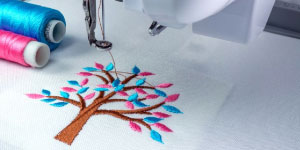Embroidery, the Art of Decorating
Decorating cloth or other materials with thread, yarn, or other fibers is the focus of the centuries-old art of embroidery, which dates back to ancient times. An embroidery is a form of needlework that may be used to create a broad variety of designs, patterns, and images due to its adaptability and level of complexity. There are numerous approaches to embroidery, including hand embroidery, machine embroidery, and computerized embroidery, amongst others. In this piece, we will concentrate on machine embroidery, which is a well-known method that is widely utilized in today’s textile manufacturing businesses.


What exactly is meant by “Machine Embroidery”?
The method of making embroidered designs with the use of specialized machines is referred to as machinery embroidery, although it’s also known as industrial embroidery. These machines are capable of producing designs with a wide number of methods, including as appliqué, satin stitching, and digitizing. The creation of patterns on cloth or other materials through the use of a needle and thread is the technique referred to as machine embroidery. The pattern is produced by manipulating the movement of the needle and thread, either manually or with the assistance of computer software. The use of machinery for embroidery allows for the creation of a wide variety of designs, such as decorative patterns, monograms, and logos.
Embroidery Machines Come in a Variety of Types:
There are numerous varieties of machine embroidery, and each one employs a distinctive method to produce embroidered patterns and designs. The following are some of the most prevalent types of embroidery machines:
A type of embroidery machine known as a single-head embroidery machine is characterized by having a single needle and a single head rather than multiple needles and heads. This machine is suited for use in embroidery tasks on a more modest size, such as the production of individualized presents or the embellishment of articles of clothing. The majority of enterprises may benefit from the simplicity and cost-effectiveness of single-head embroidery machines.
A form of embroidery machinery known as a multi-head embroidery machine, also known simply as a multi-head machine, is distinguished by the presence of several needles and multiple heads. This machine is well-suited for larger-scale embroidery operations, such as the production of individualized apparel or the generation of a large number of embroidery designs all at once. The cost of multi-head embroidery machines is more than the cost of single-head machines; nevertheless, multi-head machines are more productive and efficient.
Computerized Embroidery Machines One type of embroidery machinery is known as a computerized embroidery machine. This machine makes use of computer software to generate embroidery designs. These machines have a very high degree of precision and are able to easily generate intricate designs. As a result of its capacity to produce vast quantities of embroidered designs in a relatively short amount of time, computerized embroidery machines are frequently utilized in the textile sector.
The following are some advantages of machine embroidery:
The use of machinery for embroidery provides a number of benefits over the more traditional method of hand embroidery. The following is a list of some of the benefits of machine embroidery:
The machine embroidery process is extremely accurate and enables the creation of intricate patterns with a high degree of accuracy. Because of the great degree of expertise and attention to detail that is required, hand stitching just cannot achieve this level of precision.
Embroidery done by machine is far quicker than embroidery done by hand since machines are able to create designs in a timely and effective manner. Because of this, machinery embroidery is perfect for companies that need to produce huge quantities of embroidered designs in a relatively short amount of time.
Consistency is achieved by the use of machinery in embroidery, which guarantees uniformity in both the design and the quality of the embroidered products. The level of expertise of the person doing the hand embroidery determines both the quality and uniformity of the finished product.
The use of embroidery machines offers a more cost-efficient alternative to the traditional method of hand embroidery. The initial investment in machine embroidery equipment may be substantial; nevertheless, the cost per item embroidered is lower than the cost of hand embroidery.

